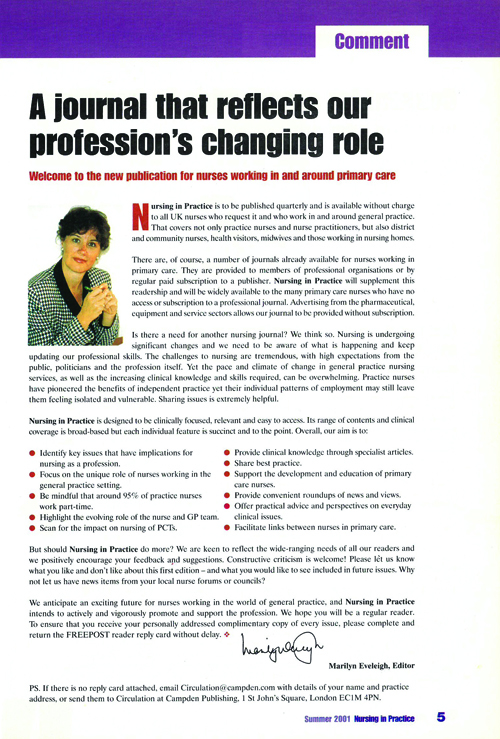Supporting the profession for 17 years

Marilyn Eveleigh has been a columnist for Nursing in Practice since its first issue. As she writes her hundredth column, she looks back at nearly two decades of change
In 2000 the publisher of the Royal College of General Practitioners Handbook had a vision to create a publication for practice nurses.
 |
|
Issue 1 of Nursing in Practice, and Marilyn’s first column |
The publisher had recognised the increased dependency of GPs on practice nurses, after a dramatic increase in employment from around 3,500 to more than 18,000, following the 1990 GP contract.
As a health authority nurse adviser guiding GPs on the role and employment of practice nurses, I was invited to establish an advisory board. This journal, Nursing in Practice, was born.
Practice nurses, with their new roles, were at the forefront of significant healthcare changes.
Related Article: MPs vote to legalise assisted dying in England and Wales
Although nurses had pioneered negotiating their own salary and benefits through being employed by independent GP contractors, most worked part time and many had no job description or contract — and were often isolated and vulnerable.
Nursing in Practice produced content that supported their clinical roles in prevention, screening and chronic disease management, plus research news and professional issues.
The Nursing in Practice advisory board pulled together nurses of different disciplines with primary and community backgrounds as well as academic and governmental organisations from all four countries, to meet twice a year. The journal’s existence was dependent on sponsorship from pharma, charities and supply companies. Four free publications annually was our aim.
Over the years, Nursing in Practice has changed. The journal is still free but is now published six times per year, with in-depth interviews with opinion leaders, clinical practice problems and photo quizzes.
In 2003 Nursing in Practice held four free events. This has now grown to 12 regional events every year, offering clinical and professional streams and well attended by a loyal following.
When we went digital with nursinginpractice.com, the website proved a tremendously popular link within the nursing fraternity. It offers CPD opportunities, an archive of all of the Nursing in Practice publications, a clinical library and thought-provoking blogs with community feedback.
Pulse, a magazine for GPs, has joined with Nursing in Practice to facilitate the multi-professional General Practice Awards, held every year. Alongside other healthcare pioneers, individual nurses, teams and specialties are recognised — and we encourage more nurses to put themselves forward.
I have had the privilege of providing a comment piece in every issue of Nursing in Practice since its inception 17 years ago — this is my hundredth. Looking back at my comments has been like reading an old diary, with smiles at my optimism, blushes at my naivety and embarrassment at my rantings.
Readers may recall that the following themes appeared frequently.
Related Article: Assisted dying bill: Two-thirds of GPNs ‘supportive’ but less sure on nurse involvement
The NHS has always suffered from change and more change. We covered the reorganisation and further re-reorganisation of primary care trusts, a separation of the providers and the commissioners of healthcare, and private companies providing NHS services — with all the damaging staff disruption, public confusion and media frenzy.
I had opinions on the plethora of new services and their requirements that impinged on nursing, particularly: NHS Direct, walk-in centres, nurse triage, Darzi centres, community matrons, the GP contract and the Quality and Outcomes Framework, nurse prescribing, and recently, the Five-Year Forward View, and the shift of healthcare to the community. Sadly, it appears the rhetoric about the expectations of the nursing profession is not matched by investment and support for the roles.
Along with many others, I have continually highlighted the crisis in nursing numbers: be it recruitment, retention, returners or retirements, they have an inevitable impact on patient safety and quality of care. This is the one theme that never goes away. There have been reports of nursing redundancies, vacancies being frozen, specialist nurses being downgraded and students not getting jobs on qualification, apparently in an attempt to make the NHS books balance. To this we now add mandatory ward nursing ratios, the Brexit effect, new rules for overseas nurses, English language tests and the short termism of international recruitment drives that have all contributed to the current 40,000 nurse vacancies. It’s a mess, but not of our making.
I have suggested that employers have inadvertently dampened the confidence and consolidation of nursing teams. It seems most nursing disciplines in most organisations are dogged by staff shortages leading to poor morale, low job satisfaction and feeling undervalued by their employers — both now and for some time. Interestingly, it appears pay is not a nursing driver.
Austerity and the cuts to social care have impinged on nursing services supporting long-term conditions in the community. There are more elderly people with greater needs who are living longer with a number of chronic diseases. This is the challenge the Government faces — and supported nursing teams are the solution. We wait while organisations learn to work together.
The most trusted of all professions
There is little doubt that professional changes have created discord in the nursing family over the years. We’ve seen nursing degrees become a requirement and revalidation become more formal and stringent. Bursaries have been exchanged for student loans. Nurse apprentices and nurse associates have been created alongside healthcare assistants. Advanced practice remains unclear. Numerous consultations on pre- and post-registration training and workforce development have been required. Empowering the profession takes its toll.
Related Article: Government accused of ‘avoiding’ practice nurse pay disparities
Although I’ve highlighted problems here, there have been exemplary supports to nursing practice and patient safety; infection prevention, formalising safeguarding and encouraging whistle-blowing are examples. Yet editorial comments generally focus on the problems. Mine were no exception and I’m at risk of being labelled a moaner.
I believe nursing flourishes, or is diminished, in organisations and infrastructures that are determined by others: and we stand by in hope. Reflecting on the national challenges, workplace obstacles and public climate the profession has faced during the past 17 years, consideration for patients and loyalty to colleagues keeps many of us in post. If you feel undervalued, be reassured by the results of a recent public poll: nurses are the most trusted of all professions. That is a fantastic accolade.
I’m proud to be a nurse. It gives me the continued drive to raise issues that impact on our reputation or enhance our status — and which readers can relate to, wherever they work.

See how our symptom tool can help you make better sense of patient presentations
Click here to search a symptom


Marilyn Eveleigh has been a columnist for Nursing in Practice since its first issue. As she writes her hundredth column, she looks back at nearly two decades of change



